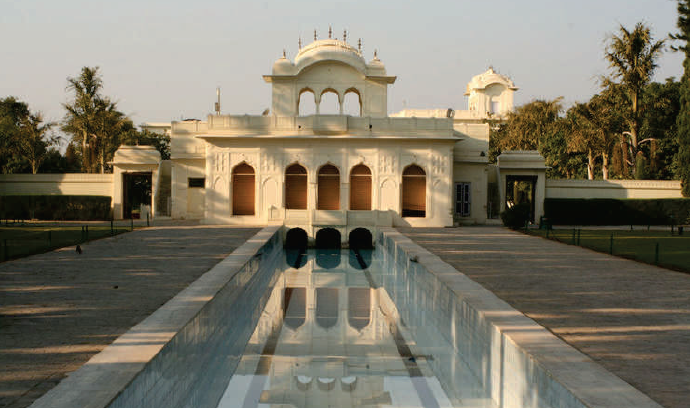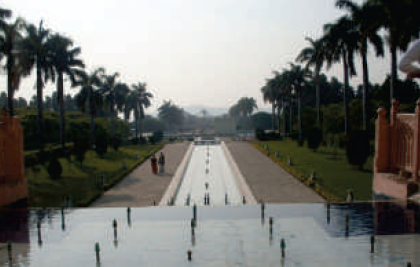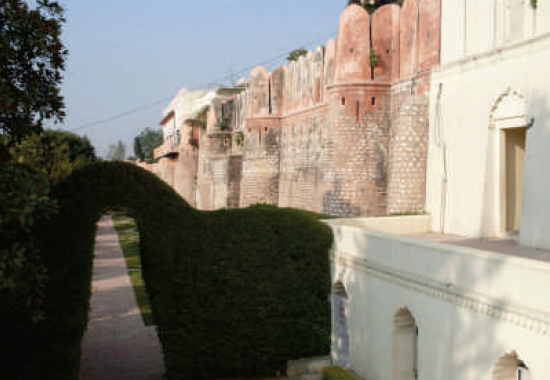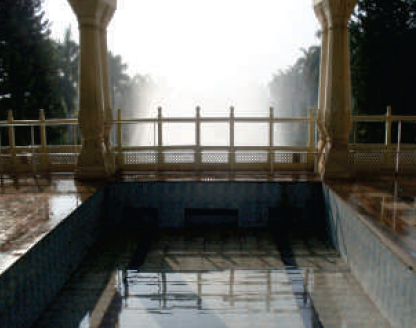Pinjore Gardens
This is a collection of articles archived for the excellence of their content. Readers will be able to edit existing articles and post new articles directly |
Pinjore Gardens
Magical Verdure
By Geeta Nandakumar
India Harmony VOLUME - 1 : ISSUE - 5 JULY-AUGUST, 2012
Pinjore, in Haryana has the most exotic and oldest surviving Mughal Gardens in the country. The murmuring water course, the lushness of the foliage, the heaviness of perfume from exotic flora, tinkling fountains, shady walks and colourful flower beds, the manicured lawns and the unyielding outer wall of a fortress, now Pinjore's Yadavindra Gardens, were part of his grand vision, his earthly anticipation of a paradise to come. Five centuries later, today, the Nawab's legacy the Pinjore Gardens are still intact, blossoming, blooming and reminiscent of the days of yore.
Located at the foothills of the Shivalik ranges, the most magnificent Mughal Gardens were built early in the 17th century by Nawab Fadai Khan, a great architect and foster brother of the Mughal emperor Aurangzeb.
At that time, the Nawab was the Governor of the Province and during one of his tours, he happened to visit the Pinjore valley. The beauty of the place mesmerised him and he wanted to make a beautiful garden where nature's bounty flourished. And thus, was born the concept of the Pinjore Gardens. Designed in the classical Charbagh pattern the beautiful gardens have a central waterway. Both sides of the waterway have a rich foliage cover with tall trees – palms, cypress and magnolia and there are beautiful flowerbeds and shrubs bordering the waterways, lending an immensely enchanting aura.
Designed beautifully like Kashmir's famous Shalimar and Nishat Gardens, Yadavindra Gardens is one of its kind in a long line of Mughal Gardens. It is distinct from the others, as it is made on a descending scale, unlike the other Mughal Gardens that show ascending steps. The seven terraces at Pinjore descend into the distance, creating an illusion of stretching into the zenith and achieving a magical effect. In the near distance, the green Himalayas tower over the old garden walls and bastions of the gardens.
There are seven descending terraces each flanked by well laid out lawns and flower beds, cool shady walks, flagged pathways and creeper covered walls. Waters cascade down the seven levels. The gardens have a sloping ground and are adorned with fountains and grand pavilions The watercourse traipsing from level to level sparkles in the sunlight, its pools reflecting white shining pavilions and balconies etched high against a blue sky. The stylishly arched balconies and shining fountains, luxuriant green lawns and murmuring watercourse, limpid poolsand the awesome greenery, unusual descending terraces and monumental gateways - all are carefully planned to lend that special aura.
The charm of this unique seven-tiered garden is unparalleled and the splendour of the days gone by is still evident in the three pleasure palaces Rang Mahal, Sheesh Mahal and Jal mahal. From the stylistic Sheesh Mahal (glass palace) built in the Rajasthani-Mughal style, the watercourse with its never-ending bubbling music cascades from terrace to terrace, flowing under the towering Rang Mahal (painted palace), and then playing around the cube-like Jal Mahal (palace in water), which was added later by the Maharaja of Patiala.
The Gardens appear spectacular and more imposing during night times when colorful lights are on and fountains get illuminated - the descending terraces providing a miraculous effect.
The Gardens served as the perfect retreat for the war-fatigued Nawab accompanied by his queens and consorts. However, the Nawab could not stay there for long. The hill rajas fearful of the increasing interest of the Mughals in the area and uneasy about the security of their kingdoms, sent goitre-stricken women (the area was deficient in iodine and goitre cases were common) to frighten the Nawab and his courtiers away.The plan worked and the Nawab never came back. After Fidai Khan's departure and the end of Mughal rule, the gardens was overtaken by wilderness.
Maharaja Bhupinder Singh of Patiala, a great lover of greenery, bought exotic trees from far and wide and planted them in the gardens. However, it was Maharaja Yadavindra Singh of Patiala after whom the Gardens got their present name. He restored Pinjore Gardens to its former glory, rejuvenating it and frequently visiting it. In 1966, it was handed over to the newly formed Haryana state.
Pinjore, home to these splendid gardens, is a site steeped in history. The narratives go back in time down historical pathways and religious dimensions to the period of the Mahabharata, winding to the remains of a temple nearby built in the 9th century. Legend has it that the Pandavas wandered in the jungles of Pinjore, then Panchpura, during their exile, long before the creation of the Mughal Gardens. Now, various additions like a zoo, a Japanese garden and several picnic spots have been added and the annual mango festival during the summer months after Baishaki are a major draw too.






